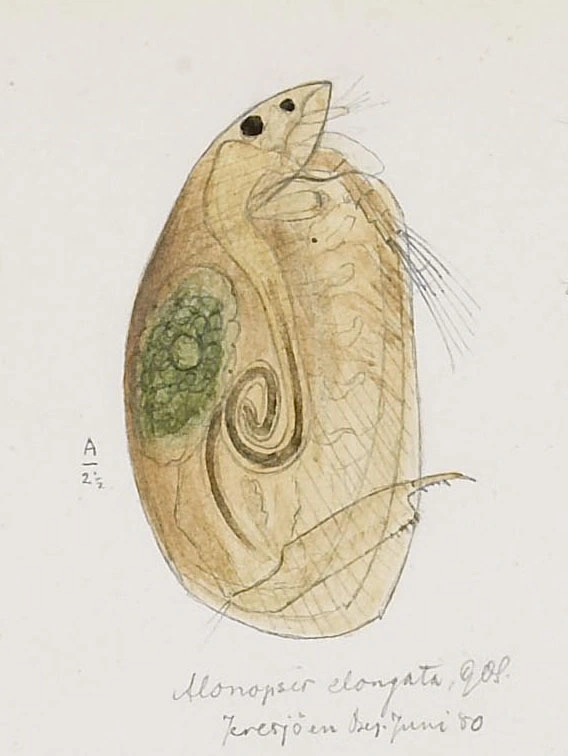Rhynchotalona falcata
Rhynchotalona falcata differs markedly from all other species by having an extremely long and curved rostrum. It is most common on stony/sandy substrate and widely distributed in Norway.
Key characteristics
Rhynchotalona falcata (female)
Because of the shape and structure of the carapace, Rhynchotalona falcata is quite close to Alona spp. However, R. falcata differs markedly from Alona spp having a long and curved rostrum. In contrast to most other chydorids, the eyespot is markedly smaller than the eye. Its carapace has a very characteristic striping. The postabdomen is very characteristic being relatively short and of uniform width, and have three coarse teeth on the end which lengthen towards the posterior end. The carapace is rather transparent with a tinge of pale yellow.
Female: Length 0.4–0.6 mm
Male: Length 0.3–0.4 mm
Ecology and distribution
R. falcata is found in approximately 20 % of the localities, and is distributed in all parts of Norway. It occurs from sea level and up to 1500 m a.s.l. The species occurs in water bodies of all sizes, with the highest frequency in localities of medium size. It is most common on stony/sandy substrate but is also found in different sorts of vegetation. R. falcata seems to be tolerant towards pH (3.9–8.2) and occurs with the same frequency in localities with both low and high pH. It lives in both electrolyte poor and electrolyte rich/brackish waters (0.5 to 957.0 mS/m).
| Vitenskapelig navn | < 4,5 | 4,5 - 4,9 | 5,0 - 5,4 | 5,5 - 5,9 | 6,0 - 6,4 | 6,5 - 7,0 | 7,0 - 7,4 | > 7,5 |
|---|---|---|---|---|---|---|---|---|
| 18 | 27,2 | 19,5 | 25,6 | 23,5 | 19 | 19 | 11,1 |
| Vitenskapelig navn | < 1,0 | 1,0 - 1,4 | 1,5 - 1,9 | 2,0 - 2,9 | 3,0 - 3,9 | 4,0 - 4,9 | 5,0 - 6,9 | 7,0 - 9,9 | > 10,0 |
|---|---|---|---|---|---|---|---|---|---|
| 14,2 | 20,3 | 27,6 | 28,1 | 25,2 | 20,4 | 21,8 | 16,7 | 4,8 |
| Vitenskapelig navn | < 0,01 | 0,01 - 0,09 | 0,1 - 0,9 | 1,0 - 9,9 | 10,0 - 99 | 100 - 999 | > 1000 |
|---|---|---|---|---|---|---|---|
| 4,9 | 5,5 | 5,9 | 10,9 | 28,4 | 41,8 | 43,5 |
| Vitenskapelig navn | < 100 | 100-299 | 300-499 | 500-699 | 700-999 | >1000 |
|---|---|---|---|---|---|---|
| 20,6 | 17,9 | 23,3 | 31,5 | 21,3 | 6 |
Look-alikes
Alonopsis elongata

